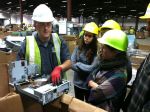The Shallow and The Deep
 David Orr, in the forward to Teaching Sustainability: Perspectives from the Humanities and Social Sciences (2013) writes about what he calls “shallow versus deep environmental education.” He noted that too much of what passes as environmental education is of the shallow kind and what we need more of is “deep” education for sustainability.
David Orr, in the forward to Teaching Sustainability: Perspectives from the Humanities and Social Sciences (2013) writes about what he calls “shallow versus deep environmental education.” He noted that too much of what passes as environmental education is of the shallow kind and what we need more of is “deep” education for sustainability.
I think we could say the same thing about experiential education. The last several decades has witnessed a rise in all sorts of experiential curricula– from service learning to problem-based learning; from internships to place-based education; and from a renewed focus on applied work to “flipped classrooms” and gamification. But, as we get busy “learning by doing,” what principles ensure that the kind of educational experience we orchestrate is deep and not shallow?
Dewey’s Lament
John Dewey, in 1936, had a similar concern. During his time, “progressivism” and “child centered” learning was all the rage. But, as he watched practitioners implement these ideas, he grew increasingly concerned. He noted:
“An experience may be immediately enjoyable and yet promote the formation of a slack and careless attitude… Each experience may be lively, vivid, and ‘interesting,’ and yet their disconnectedness may artificially generate dispersive, disintegrated, centrifugal habits… They are then taken, either by way of enjoyment or of discontent and revolt, just as they come… Traditional education offers a plethora of examples of experiences of the kinds just mentioned. (1936, p. 26)”
Indeed, even now, in 2014, we have a plethora of examples of such “shallow” experiential education. The internship with no support, the boring field trip, and the disconnected service project. How do we avoid this? In this series of blogs, I will explore 5 principles of “deep” experiential design. We will start with principle #1.
Principle #1 FRAMING
This is one of the things most beginner experiential practitioners under-emphasize. Framing refers to how you set up the experience as a learning endeavor. Recent research on the neuroscience of learning has indicated how important it is to make learning outcomes overt for students. Too often, we simply assume students know why it is they are going through a given experience. In my context in higher education, this is certainly the case around the liberal arts, for example. We assume our students know what the “liberal arts” are and why they might be important to their education. Yet ask any undergraduate to articulate a definition and value statement around the “liberal arts” and see what you get… usually not much.
The point is that good framing sets students up for transformative experiences. It puts questions into their head they can then bring to the learning. A good frame invites the student in. But be careful, you can also “over-frame.” Spending too much time framing an experience is disengaging. It is what one educator described as the difference between the “gum” and the “chewing.” It is frustrating for students to have the instructor unceasingly point out the “gum”… “See this? This is gum! Here is the gum wrapper. Notice the color of the gum? It is purple…” Students want to chew the gum, not just hear about it. You can think of a bad 55 minute lecture as, in essence, over- framing. It is all gum and no chewing. A good frame puts students in an anticipatory state and it gets them salivating for the gum chewing.
Frames can be shorter or longer depending on the size of the curriculum project. A 55 minute class might have a 5 minute frame. A semester-long study abroad might spend several weeks “framing” the experience (including the orientation period).
Here are some things I think through as I design an experiential project:
- What prior knowledge do my students have on this subject?
- What pre-exposure to the content or subject will peak their curiosity?
- What socratic questions will encourage critical thinking as they go through the experience?
- How can I make the relevance of this clear and overt but simultaneously intriguing and exploratory?
- How am I going to invite them in?
Good framing is the difference between being a tourist and a traveller. The tourist has Dewey’s “lively and enjoyable experiences” but the traveller goes deeper. Successful experiential education designers always think carefully about how they will FRAME the experience. It is a key difference in shallow versus deep experiential education.
In the next blog, we’ll discuss Principle #2 INTERACTION. Stay tuned!
Jay – This is a wonderful series you have embarked upon and well needed. Quick question: you mention transformation; how do you envision transformation of the learner? Can you name it?
Thanks Matt. Good question on the issue of transformation. I think most deep experiential education has “transformation” or “transformative learning” as an outcome. Mezirow talks about transformative learning this way:
“A defining condition of being human is that we have to understand the meaning of our experience. For some, any uncritically assimilated explanation by an authority figure will suffice. But in contemporary societies we must learn to make our own interpretations rather than act on the purposes, beliefs, judgements, and feelings of others. Facilitating such understandings is the cardinal goal of adult education. Transformative learning develops autonomous thinking.”
Transformative learning is not just thinking though– it is holistic process and includes self awareness, social embededness, and behavior change. I suppose to me transformative learning is the ability to imagine things otherwise and then go about actualizing that not-yet reality. In many ways, this ought to be a central aim of education more broadly. I am sure others would have more to say here. See: http://transformativelearningtheory.com/corePrinciples.html